calsfoundation@cals.org
Crater of Diamonds State Park
| Location: | Pike County |
| Area: | 911 acres |
Located on State Highway 301 in Pike County, the Crater of Diamonds State Park contains the world’s only diamond mine that is open to the public.
John Wesley Huddleston, a farmer and sometime prospector, first found diamonds on the site in 1906. Huddleston’s discovery sparked a diamond rush in Pike County. Diamond-bearing soil was also found on Millard M. Mauney’s property that was adjacent to Huddleston’s. Prospectors and fortune hunters rushed to the area, and soon the town of Kimberly developed to accommodate the influx of people.
Within a few years of the discovery, all the land on top of Prairie Creek Pipe was in the hands of two rival companies, Arkansas Diamond Company and Ozark Diamond Mines Corporation. The two companies maintained mining operations sporadically over the next forty years but operated under constant financial strain, poor management, lawsuits, and sabotage.
In 1924, a 40.23-carat diamond was found by Wesley Oley Basham, a workman for the Arkansas Diamond Company. The diamond was dubbed with Basham’s nickname, and the “Uncle Sam,” as it is called, still holds the record as the largest diamond ever found in the United States.
The owners of the rival companies formed a partnership in 1952 and opened the property to the public as a tourist attraction called the Crater of Diamonds. For a nominal fee, visitors were allowed to search for diamonds and keep what they found. The venture was a modest success from the start. Well-known diamonds found during this time included the 15.33-carat Star of Arkansas (1956), the 6.42-carat Gary Moore diamond (1960), and the 34.25-carat Star of Murfreesboro (1964).
The Crater of Diamonds was purchased by the state of Arkansas in 1972 and established as Crater of Diamonds State Park. Each year, the park hosts thousands of visitors and averages two diamonds found daily. Crater diamonds are usually less than a carat in size and come in all colors, with white, yellow, and brown being the most common. They are usually smooth and rounded in appearance and have an almost metallic luster. In addition to diamonds, the search field also yields agate, jasper, quartz, and amethyst. The park was listed on the National Register of Historic Places on June 18, 1973.
Arguably, the most well-known diamond found since the area became a state park is the Strawn-Wagner. Shirley Strawn of Murfreesboro (Pike County) found this 3.03-carat diamond in 1990. It was cut to a 1.09-carat brilliant shape and certified as a perfect D flawless diamond, the highest quality diamond ever graded by the American Gemological Society. Strawn gave the diamond her name and that of her great-great-grandfather, Lee Wagner. The diamond is on display at the park. In the early 1990s, Governor Bill Clinton signed a bill to authorize a lease for commercial exploration and mining at the park. Four companies participated in a cooperative project to explore the possibility of mining the area. By 1994, the land had not yielded enough return to make a full-scale mining operation viable, and the companies withdrew. Since 1996, additional tests and sampling have resulted in minimal yields.
The park encompasses 911 acres of woodland along the Little Missouri River, including a 37-acre search field visitors can access for a small admission fee. The search field sits atop an ancient volcanic vent called the Prairie Creek Pipe. The volcanic explosion that formed this pipe more than 100 million years ago brought diamonds from deep within the earth’s mantle to the surface.
For additional information:
Arkansas State Parks–Crater of Diamonds. http://www.craterofdiamondsstatepark.com/ (accessed July 6, 2023).
Caillouet, Linda S. “Diamond, Diamond…” Arkansas Democrat-Gazette. March 13, 2012, pp. 1E, 6E.
Friedman, Samantha. “Gem Dandy.” Arkansas Democrat-Gazette. June 15, 2006, p. 1E, 6E.
Hendrix, Bobbie Lou. Crater of Diamonds: Jewel of Arkansas. Antoine, AR: B. L. Hendrix, 1989.
Millar, Howard A. It Was Finders-Keepers at America’s Only Diamond Mine. New York: Carlton Press, 1976.
Riderer, Rachel. “The Amateur Miners Who Dig through More than Dirt.” New Yorker, December 15, 2021. https://www.newyorker.com/culture/the-new-yorker-documentary/the-amateur-miners-who-dig-through-more-than-dirt (accessed July 6, 2023).
Wilcox, Jerry D. Arkansas’ Incredible Diamond Mine Story. N.p.: Jerry D. Wilcox, 1981.
Worthington, Glenn W. A Thorough and Accurate History of Genuine Diamonds in Arkansas. Murfreesboro, AR: Mid-America Prospecting, 2003.
Staff of the Arkansas Department of Parks and Tourism
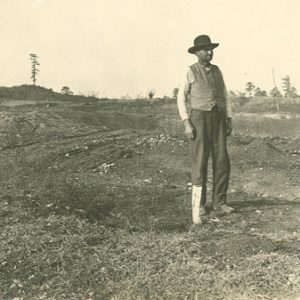 Crater of Diamonds
Crater of Diamonds 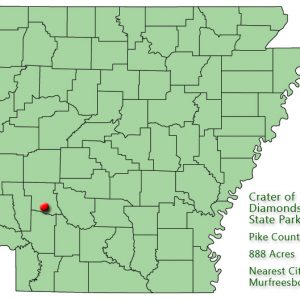 Crater of Diamonds State Park: Park Location
Crater of Diamonds State Park: Park Location 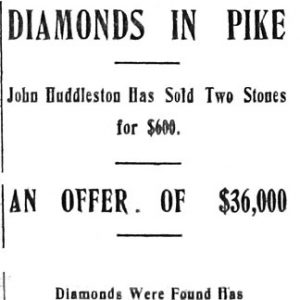 Diamond Discovery Announcement
Diamond Discovery Announcement 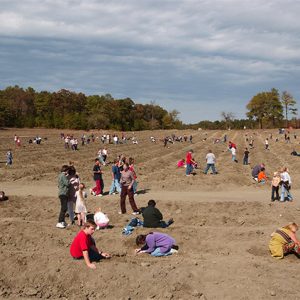 Diamond Field
Diamond Field 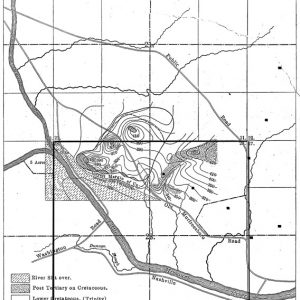 Diamond Pipe Map
Diamond Pipe Map 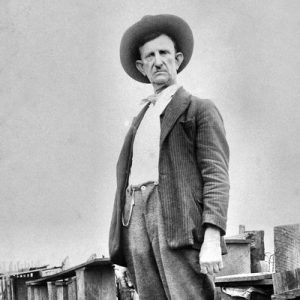 John Huddleston
John Huddleston 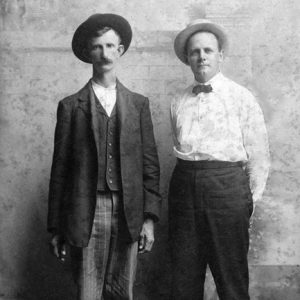 John Huddleston and Sam Reyburn
John Huddleston and Sam Reyburn 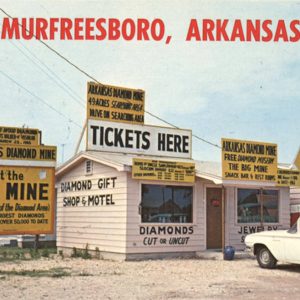 Murfreesboro Postcard
Murfreesboro Postcard 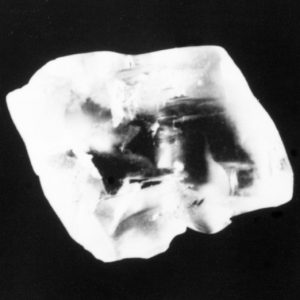 Uncle Sam Diamond Rough
Uncle Sam Diamond Rough 



Comments
No comments on this entry yet.